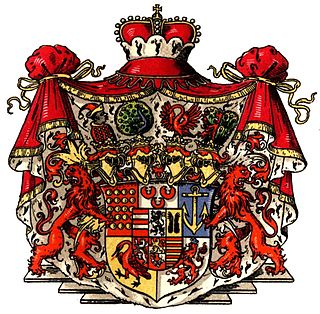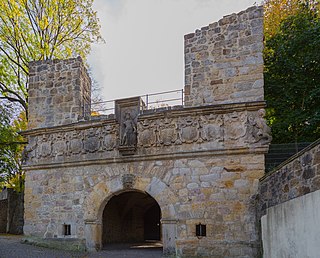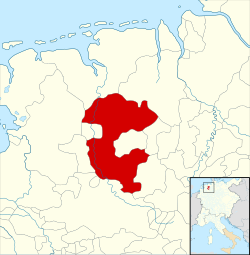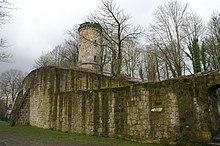
Lower Saxony is a German state in northwestern Germany. It is the second-largest state by land area, with 47,614 km2 (18,384 sq mi), and fourth-largest in population among the 16 Länder federated as the Federal Republic of Germany. In rural areas, Northern Low Saxon and Saterland Frisian are still spoken, albeit in declining numbers.
County of Bentheim is a district (Landkreis) in Lower Saxony, Germany. It is bounded by the Dutch provinces of Overijssel and Drenthe, the district of Emsland, and the districts of Steinfurt and Borken in North Rhine-Westphalia.

Tecklenburg is a town in the district of Steinfurt, in North Rhine-Westphalia, Germany. Its name comes from the ruined castle around which it was built. The town is situated on the Hermannsweg hiking trail.

Bad Bentheim is a town in the southwestern part of Lower Saxony, Germany, in the district of Grafschaft Bentheim on the borders of North Rhine-Westphalia and the Netherlands roughly 15 km south of Nordhorn and 20 km northeast of Enschede. It is a state-recognized thermal brine and sulphur spa town, hence the designation Bad (“Bath”). Also to be found in Bad Bentheim is the castle Burg Bentheim, the town's emblem.

Bentheim-Tecklenburg-Rheda was a historical county of the Holy Roman Empire, located in present northwestern North Rhine-Westphalia and southwestern Lower Saxony, Germany.

Bentheim-Steinfurt was a historical county located in northwestern North Rhine-Westphalia in the region surrounding Steinfurt, Germany. Bentheim-Steinfurt was a partition of Bentheim-Bentheim, itself a partition of the County of Bentheim. Bentheim-Steinfurt was partitioned: between itself and Bentheim-Tecklenburg-Rheda in 1606; and between itself and Bentheim-Bentheim in 1643.

Bentheim-Tecklenburg was a German county based in the region around Tecklenburg in northern North Rhine-Westphalia, Germany.

The County of Bentheim was a state of the Holy Roman Empire, located in the south-west corner of today's Lower Saxony, Germany. The county's borders corresponded largely to those of the modern administrative district (Landkreis) of Grafschaft Bentheim.

The German Emperor was the official title of the head of state and hereditary ruler of the German Empire. A specifically chosen term, it was introduced with the 1 January 1871 constitution and lasted until the official abdication of Wilhelm II on 9 November 1918. The Holy Roman Emperor is sometimes also called "German Emperor" when the historical context is clear, as derived from the Holy Roman Empire's official name of "Holy Roman Empire of the German Nation" from 1512.

The Province of Hanover was a province of the Kingdom of Prussia and the Free State of Prussia from 1868 to 1946.
These are lists of political office-holders in Germany.

Tecklenburg Castle, or simply the Tecklenburg, is a ruined castle and venue for the Tecklenburg Open-Air Theatre in the eponymous town of Tecklenburg in the county of Steinfurt in the state of North Rhine-Westphalia, Germany. It was once the seat of the rulers of the County of Tecklenburg.
Alexius Frederick, Prince of Bentheim and Steinfurt was a German nobleman.
The Hanoverian Western Railway was a line from the Löhne to Emden, built by the Royal Hanoverian State Railways in the mid-19th century in the west of the Kingdom of Hanover in the modern German states of Lower Saxony and North Rhine-Westphalia.

Arnold III of Bentheim-Tecklenburg-Steinfurt-Limburg was a German nobleman. He was Count of Bentheim, Tecklenburg and Steinfurt, and jure uxoris Count of Limburg. He ruled as Arnold IV in Bentheim and Tecklenburg, and as Arnold II in Steinfurt. In Limburg, he was the first Count named Arnold and hence just the name distinctive.

Eberwin III, Count of Bentheim-Steinfurt was a German nobleman. He was a member of the elder line of the House of Bentheim-Steinfurt and was the ruling Count of Bentheim and Steinfurt from 1544 until his death. From 1557, he was also Count of Tecklenburg and Lord of Rheda by marriage.
The German Emperors after 1873 had a variety of titles and coats of arms, which in various compositions became the officially used titles and coats of arms. The title and coat of arms were last fixed in 1873, but the titles did not necessarily mean that the area was really dominated, and sometimes even several princes bore the same title.
Anna von Tecklenburg-Schwerin (1532-1582) was the ruling suo jure Countess of Tecklenburg and the lordships of Wevelinghoven and Rheda between 1557 and 1582. She was regent of the County of Bentheim-Steinfurt during the minority of her son in 1562–1573.

The County of Steinfurt, originally the Lordship of Steinfurt, was a historic territory of the Holy Roman Empire in the Munsterland. It existed from roughly 1100 until 1806.
This page is based on this
Wikipedia article Text is available under the
CC BY-SA 4.0 license; additional terms may apply.
Images, videos and audio are available under their respective licenses.
















